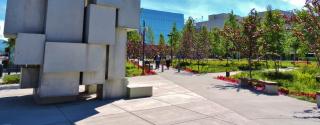An anchorage is a safe place, a shelter for ships and visitors on board. Before 1915, most settlers referred to what became the city of Anchorage as the Knik Anchorage, the literal anchorage for the now long-abandoned town of Knik across the water. Amidst the tides and mudflats, the area around Ship Creek was the safest place to anchor.
When Anchorage was established in 1915 as a central hub for railroad construction, the residents argued over a name for the new town. The railroad people wanted to name the settlement after its central stream: Ship Creek. Alaska Governor John Alexander Strong liked the idea of Matanuska. The governor was later revealed as a fraud, not the American military veteran as he frequently claimed, but instead a Canadian vagabond. But that revelation was a couple of years away, so his advocates proposed Strong in his questionable honor.
Some government representatives thought the town should be named after President Woodrow Wilson, either Woodrow Creek or Woodrow. Others preferred Lane for Secretary of the Interior Franklin Lane. Another strong contingent saw the potential in the new townsite. They dreamed of it becoming the centerpiece of the territory, thus deserving the name Alaska City.
Further ideas included Mearsville, Whitney, Winalaska, Gateway, Homestead, and the more ominous, if understandable, Terminal. Mears referred to railroad executive Frederick Mears. Whitney meant John and Daisy Whitney who had lived along Ship Creek since 1911. Whitney Road, immediately north of the creek, is named for them. Lastly, the more sourdough participants in the discussion still called it Knik Anchorage, or just Anchorage.
When the railroad overseers and laborers arrived, a Dena’ina Athabascan fishing camp was at the mouth of Ship Creek. To them, the creek and its mouth are Dgheyay Leht (Stickleback Creek) and Dgheyay Kaq’. Other Dena’ina names for the Anchorage area include Qatuk’e’usht, meaning Something Drifts Up to It, and Ves Dnaghildeqt, meaning High Bank.
In the summer of 1915, the residents of To Be Determined held an election “as to what the name of their town should be hereafter.” With 146 votes, Alaska City was the victor followed closely by Lane with 129 votes. Anchorage finished third with 101 votes. Matanuska, Ship Creek, Winalaska, Terminal, Gateway, and Homestead followed with 54, 48, 18, 16, 10, and 9 votes, respectively.
The results pleased a plurality of the voting populace but not anyone with the power to enforce the outcome. Every single relevant government agency ignored the results. Most notably, the postal service maintained the town was Anchorage, which ensured the eventual conclusion to the debate. No matter what residents or other organizations wanted to call the town, if they wanted a package delivered, they needed to address it for Anchorage.
Young Anchorage was a small town. After a brief railroad construction boom, there were less than 2,000 people living within city limits by the 1920 Census. Yet, one minor design quirk survives. In its earliest years, Anchorage was designed and governed by the railroad. And in a place of muskeg, forests, and cliffs, the planners installed a traditional grid, with streets designated with numbers and letters. Yet, one letter is missing.
A glance at a current map reveals no J Street, skipping from I to K. Local legend says Norwegian settlers struggled to pronounce the letter, no matter that the layout was overseen by Andrew Christensen, who was not only Danish but raised in the United States. The simple truth is that J is too similar to I when written and A when spoken. For the same reason, there has never been a permanent J Company in the Army or Marines. Some other planned cities, such as Washington, D.C., also skip J Street. Similarly, I Street was often printed and written as Eye Street for the sake of clarity.
David Reamer Jr.
David Reamer is an academic and public historian interested in the intersections of community development and social justice. He is the coauthor of the 2022 Black Lives in Alaska, co 2023 Alaska Historian of the Year, and the author of the weekly "Histories of Alaska" series for the Anchorage Daily News.


